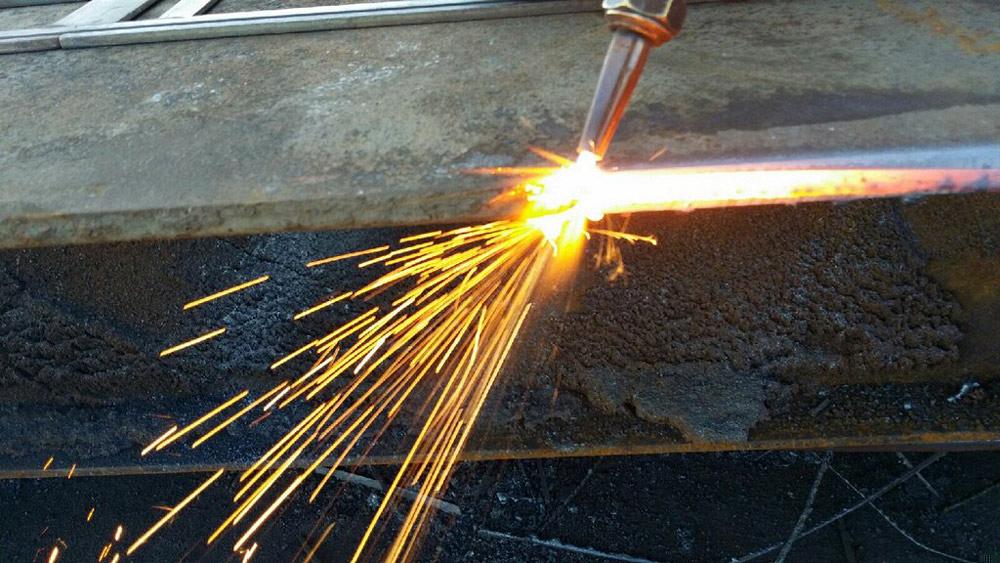Senior Editor
- FMA
- The Fabricator
- FABTECH
- Canadian Metalworking
Categories
- Additive Manufacturing
- Aluminum Welding
- Arc Welding
- Assembly and Joining
- Automation and Robotics
- Bending and Forming
- Consumables
- Cutting and Weld Prep
- Electric Vehicles
- En Español
- Finishing
- Hydroforming
- Laser Cutting
- Laser Welding
- Machining
- Manufacturing Software
- Materials Handling
- Metals/Materials
- Oxyfuel Cutting
- Plasma Cutting
- Power Tools
- Punching and Other Holemaking
- Roll Forming
- Safety
- Sawing
- Shearing
- Shop Management
- Testing and Measuring
- Tube and Pipe Fabrication
- Tube and Pipe Production
- Waterjet Cutting
Industry Directory
Webcasts
Podcasts
FAB 40
Advertise
Subscribe
Account Login
Search
Oxyfuel cutting thick, fast—and safely
Company reports that lighter-than-air fuel gas helps make a dangerous job safer
- By Tim Heston
- August 11, 2015
- Article
- Oxyfuel Cutting
Grover White knows his field fabricators sometimes resort to a belly crawl.
Titan Contracting & Leasing, a large industrial fabricator, expanded its Florida operations in June 2014. As manager of field fabrication in Homosassa, north of Tampa, White works with a team of technicians who go on-site to repair and refurbish various components used in power generation, including boilers. To access the inner chambers, they sometimes crawl through holes only several feet wide. Once the techs are inside, their helpers feed them tools to cut, remove, or repair components. One of those tools happens to be an oxyfuel cutting torch with a hose attached to the gas bottle outside.
“When you pull that hose in there, you’re pretty much putting yourself at risk,” White said. “If anything were to happen to that hose [such as a leak], you’ve got yourself shut up inside a live bomb. There’s no place you can go.”
That’s a worst-case scenario, which is why the industry goes to great lengths to ensure it doesn’t happen. Nationwide, the Titan organization maintained a zero total reportable incident rate (TRIR) from 2012 to 2014. It accomplished this through safety training, as well as considering alternative procedures that eliminate or reduce the risk potential. One alternative, White said, has come with a new kind of oxyfuel cutting gas.
Produced by MagneGas Corp., the gas burns in a highly concentrated flame, which helps attain high cutting speeds. The company reports that at tests conducted last year at Columbus, Ohio-based EWI, a mechanized oxyfuel cutting setup cut 3.5-in.-thick plate at 18 IPM.
Most significant for White’s operation, the gas is lighter than air, which improves safety. Typical oxyfuel gases are heavier than air, so in the event of a leak in a confined space, the gas falls to the floor—a hazard waiting for an ignition source.
Because the latest version of MagneGas is lighter than air, the gas from a leak would float upward and dissipate. As long as the confined space has somewhere for the gas to vent out, the company says, it significantly reduces the inherent risks of fabricating in tight spaces. Recently MagneGas posted a YouTube video taken at an outdoor shooting range. When the rifleman shot at the cylinder of MagneGas, the bottle exploded, yet there was no fiery flame, and the explosion didn’t spread.
Industrial gas production is a dangerous business, and MagneGas experienced that firsthand. Earlier this year, a fatality occurred after an industrial accident (termed “mechanical failure” by local fire and rescue investigators) at MagneGas’ Tarpon Springs, Fla., plant, where a bottle vented and exploded. According to CEO Ermanno Santilli, the explosion did not spread to other bottles in the plant.
“The fire service was expecting it to be a typical industrial gas explosion, where you have multiple secondary explosions from nearby bottles,” he said. “The only bottle that was affected was the bottle that failed. And at this stage of the investigation, [the regulatory authorities] have not found, nor has MagneGas been cited for, any issues regarding the production of, the handling of, or labeling of the gas.
“We are moving to a more automated procedure,” Santilli continued, “so there’s less human intervention.” The company has appointed a new director of safety, a former U.S. Navy compliance specialist, and in June restarted its gas production in Florida.

According to tests performed by the City College of New York, the fuel produces a cutting flame that’s 10,500 degrees F.
MagneGas’ roots go back to the late 1990s, when the CEO’s father, Dr. Ruggero Santilli, developed what the company calls Plasma Arc Flow™, a plasma arc gasification technology that basically converts a liquid biomass, anything from used antifreeze to waste vegetable oil to sludge and sewage, into a fuel gas. According to tests performed by the City College of New York, the resulting fuel produces a cutting flame that’s 10,500 degrees F.
The gas production process starts with a liquid biomass material flowing into a chamber, where it becomes vaporized between two strategically placed electrodes. What happens next is proprietary, but according to sources, what makes the process effective is where the electrodes are and how the liquid biomass flows around them. After gasification, the remaining charcoal-like residue falls out of the system, and the resulting fuel gas flows into the storage tank for distribution.
According to sources, the amount of carbon in the biomass is what makes the difference in the fuel gas’s cutting performance. Warping is minimal, and thick workpieces can be touched immediately after cutting.
The company’s first iteration of the gas used ethylene glycol, a component of antifreeze. The resulting gas burned hot and clean, but it did have a bit of a learning curve for some, especially for manual cutting, mainly because the flame was difficult to see outside. So last year the company introduced MagneGas2®, a gas developed from waste cooking and other vegetable-based oil from the restaurant industry. According to the company, this gas produces a flame that’s easier to see and more familiar to those who have worked with oxyfuel gases like acetylene or propylene.
The company is targeting several other markets besides metal fabrication. The gas can be used as a “portable gasifier” that can neutralize unwanted waste or sterilize manures, converting them into irrigation water and fertilizer. It also can fuel vehicles that can accept compressed natural gas and is being used by firefighters and first responders for use during extractions.
For oxyfuel cutting applications, the company reports that because the heat is highly concentrated, the flame tends to cut with a narrow kerf and (for an oxyfuel process) a very narrow heat-affected zone. It also brings material up to kindling temperature quickly with minimal preheating.
From White’s perspective at Titan, higher cutting speed also means that field fabricators need to spend less time in tight spaces with a cutting flame.
Images courtesy of MagneGas Corp., 150 Rainville Road, Tarpon Springs, FL 34689, 727-934-3448, www.magnegas.com.
About the Author

Tim Heston
2135 Point Blvd
Elgin, IL 60123
815-381-1314
Tim Heston, The Fabricator's senior editor, has covered the metal fabrication industry since 1998, starting his career at the American Welding Society's Welding Journal. Since then he has covered the full range of metal fabrication processes, from stamping, bending, and cutting to grinding and polishing. He joined The Fabricator's staff in October 2007.
subscribe now

The Fabricator is North America's leading magazine for the metal forming and fabricating industry. The magazine delivers the news, technical articles, and case histories that enable fabricators to do their jobs more efficiently. The Fabricator has served the industry since 1970.
start your free subscription- Stay connected from anywhere

Easily access valuable industry resources now with full access to the digital edition of The Fabricator.

Easily access valuable industry resources now with full access to the digital edition of The Welder.

Easily access valuable industry resources now with full access to the digital edition of The Tube and Pipe Journal.
- Podcasting
- Podcast:
- The Fabricator Podcast
- Published:
- 04/16/2024
- Running Time:
- 63:29
In this episode of The Fabricator Podcast, Caleb Chamberlain, co-founder and CEO of OSH Cut, discusses his company’s...
- Trending Articles
Tips for creating sheet metal tubes with perforations

JM Steel triples capacity for solar energy projects at Pennsylvania facility

Are two heads better than one in fiber laser cutting?

Supporting the metal fabricating industry through FMA

Omco Solar opens second Alabama manufacturing facility

- Industry Events
16th Annual Safety Conference
- April 30 - May 1, 2024
- Elgin,
Pipe and Tube Conference
- May 21 - 22, 2024
- Omaha, NE
World-Class Roll Forming Workshop
- June 5 - 6, 2024
- Louisville, KY
Advanced Laser Application Workshop
- June 25 - 27, 2024
- Novi, MI



























